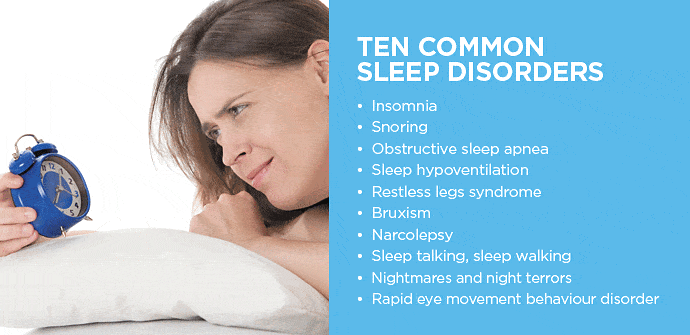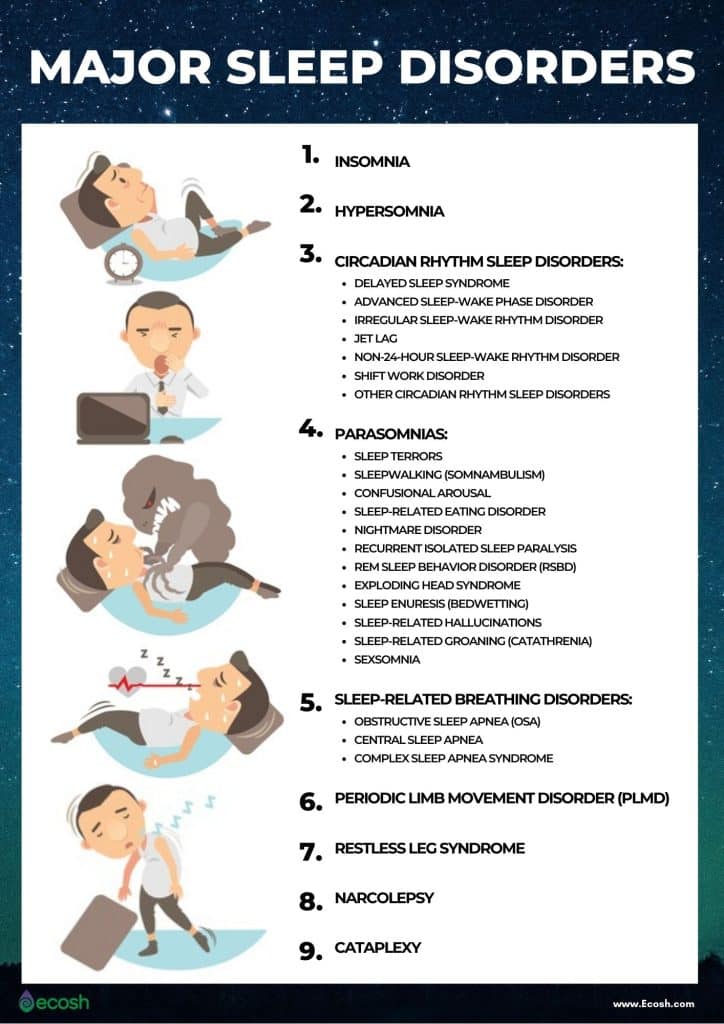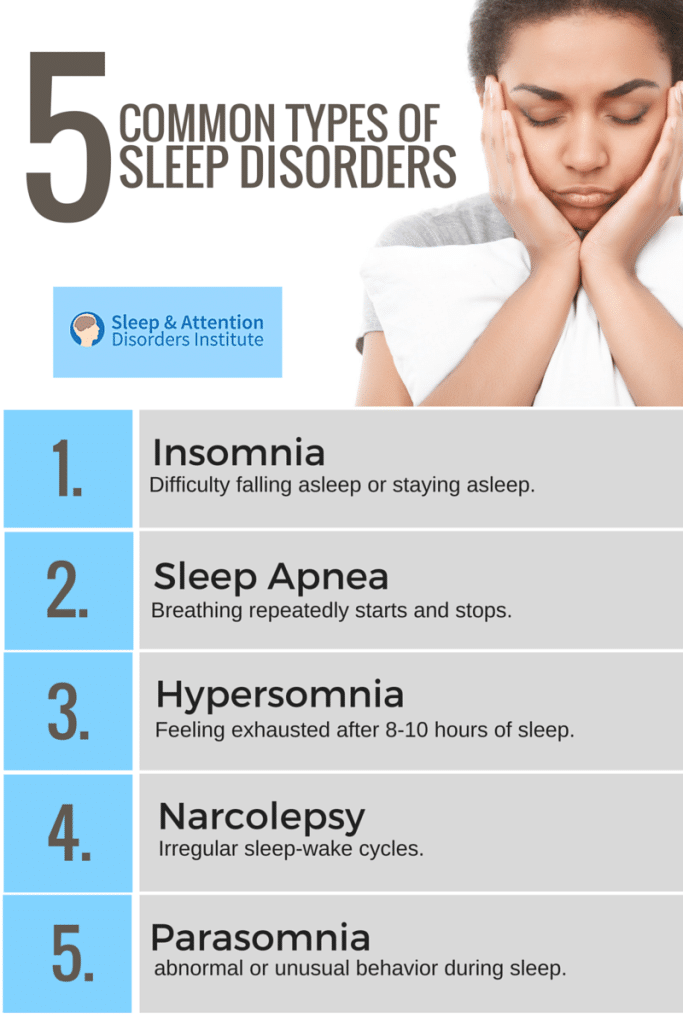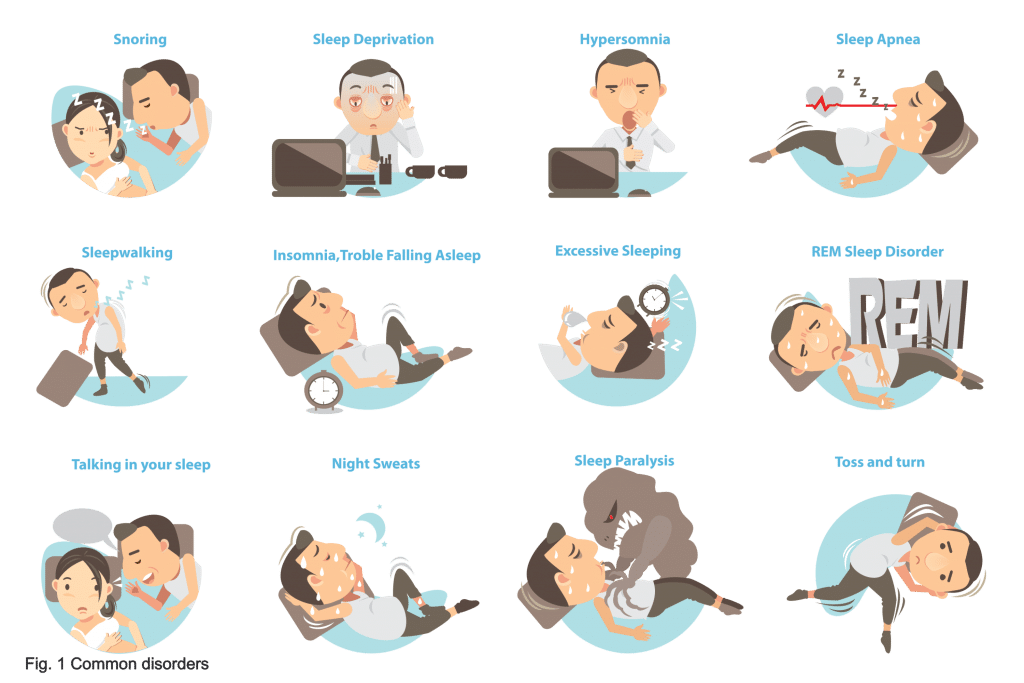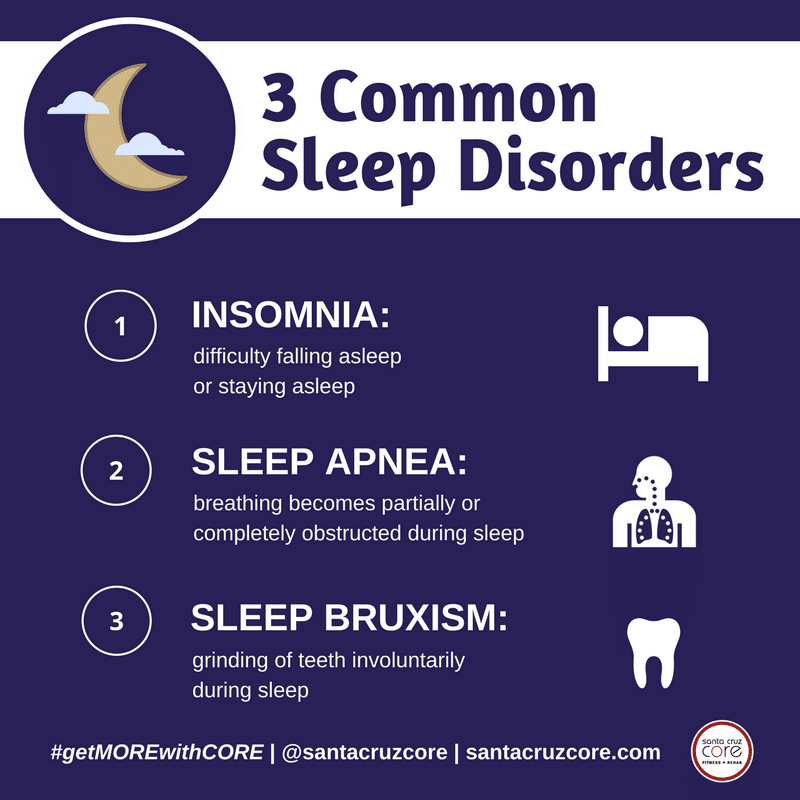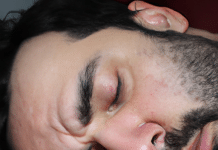Have you ever found yourself lying in bed, tossing and turning, unable to drift off into a peaceful slumber? If so, you may be familiar with the frustrating experience of a sleep disorder. From insomnia to sleep apnea, there are several common sleep disorders that can disrupt our nights and leave us feeling groggy and unrefreshed in the morning. In this article, we will explore some of these sleep disorders and shed light on their causes, symptoms, and potential treatments. So, if you’re ready to learn more about this fascinating topic, join us as we explore the world of sleep disorders.
This image is property of www.sleephealthfoundation.org.au.
Review contents
Insomnia
Definition
Insomnia refers to the difficulty in falling asleep or staying asleep, or the tendency to wake up too early and not be able to fall back asleep. It is a common sleep disorder that affects a large portion of the population.
Symptoms
The symptoms of insomnia include difficulty falling asleep at night, waking up frequently during the night, waking up too early in the morning, feeling tired upon waking, experiencing daytime sleepiness, irritability, and difficulty concentrating.
Causes
Insomnia can be caused by various factors, including stress, anxiety, depression, certain medications, caffeine or nicotine consumption, environmental factors such as noise or light, an irregular sleep schedule, or underlying health conditions such as chronic pain or sleep apnea.
Treatment
Treating insomnia often involves addressing the underlying causes and making lifestyle changes to promote better sleep hygiene. This may include practicing relaxation techniques before bed, establishing a regular sleep schedule, avoiding stimulants close to bedtime, creating a comfortable sleep environment, and seeking therapy or medication if necessary.
Sleep Apnea
Definition
Sleep apnea is a sleep disorder characterized by pauses in breathing or shallow breaths during sleep. These pauses can last from a few seconds to a few minutes and may occur multiple times throughout the night.
Types
There are three main types of sleep apnea: obstructive sleep apnea, central sleep apnea, and complex sleep apnea syndrome. Obstructive sleep apnea is the most common type and occurs when the throat muscles relax and block the airway. Central sleep apnea occurs when the brain fails to send the proper signals to the muscles that control breathing. Complex sleep apnea syndrome is a combination of both obstructive and central sleep apnea.
Symptoms
The common symptoms of sleep apnea include loud snoring, episodes of breathing cessation during sleep, abrupt awakenings accompanied by gasping or choking, excessive daytime sleepiness, morning headaches, difficulty concentrating, and irritability.
Causes
The causes of sleep apnea can vary depending on the type. Obstructive sleep apnea is often caused by factors such as obesity, a narrowed airway, genetics, or certain anatomical features. Central sleep apnea can be caused by certain medical conditions or the use of certain medications.
Treatment
Treatment for sleep apnea may include lifestyle changes such as losing weight, avoiding alcohol and sedatives, using a continuous positive airway pressure (CPAP) machine to keep the airway open during sleep, oral appliances that help keep the throat open, and surgery in severe cases.
Narcolepsy
Definition
Narcolepsy is a neurological disorder that affects the brain’s ability to regulate sleep-wake cycles. It is characterized by excessive daytime sleepiness, sudden and uncontrollable sleep attacks, and a disruption in the sleep cycle.
Symptoms
The primary symptom of narcolepsy is excessive daytime sleepiness, which can manifest as falling asleep at inappropriate times or in the middle of activities. Other symptoms may include sudden loss of muscle control (cataplexy), hallucinations, sleep paralysis, and disrupted nighttime sleep.
Causes
The exact cause of narcolepsy is still unknown, but it is believed to involve a combination of genetic and environmental factors. Some research suggests that narcolepsy may be caused by the loss of certain brain cells that produce a neurotransmitter called hypocretin, which plays a role in regulating wakefulness and sleep.
Treatment
Although there is no cure for narcolepsy, symptoms can be managed through medications and lifestyle modifications. Stimulant medications may be prescribed to alleviate excessive sleepiness, while antidepressants or sodium oxybate may be recommended to control cataplexy and improve nighttime sleep. Incorporating regular short naps and maintaining a consistent sleep schedule can also help manage symptoms.
Restless Legs Syndrome (RLS)
Definition
Restless Legs Syndrome (RLS), also known as Willis-Ekbom Disease, is a neurological disorder characterized by an uncontrollable urge to move the legs, often accompanied by uncomfortable or unpleasant sensations. These symptoms typically occur in the evening or at night, leading to difficulty falling asleep or staying asleep.
Symptoms
The primary symptom of RLS is the strong urge to move the legs, often accompanied by uncomfortable sensations such as tingling, itching, or aching. The symptoms are usually worse at rest and improve with movement. RLS can cause sleep disruption, leading to daytime fatigue and impaired quality of life.
Causes
The exact cause of RLS is unknown, but it is believed to involve a combination of genetic and environmental factors. Certain conditions such as iron deficiency, kidney disease, diabetes, and pregnancy have been associated with an increased risk of developing RLS. Medications such as antihistamines and antidepressants can also worsen symptoms.
Treatment
Treatment for RLS focuses on managing symptoms and improving sleep quality. Lifestyle changes, such as avoiding caffeine and nicotine, regular exercise, and establishing a regular sleep routine, may help alleviate symptoms. Medications such as dopamine agonists, opioids, or anti-seizure drugs may be prescribed to relieve symptoms in severe cases.
This image is property of ecosh.com.
Parasomnias
Definition
Parasomnias are a group of sleep disorders characterized by abnormal behaviors, movements, emotions, perceptions, or dreams that occur during sleep. These disorders can range from mild to severe and can significantly impact sleep quality and overall well-being.
Types
There are several types of parasomnias, including sleepwalking, sleep talking, sleep-related eating disorder, nightmares, night terrors, bedwetting (enuresis), and sleep-related hallucinations. Each type of parasomnia is associated with different behaviors and experiences during sleep.
Symptoms
The symptoms of parasomnias can vary depending on the specific type. Sleepwalking involves getting out of bed and walking or performing complex actions while asleep. Sleep talking involves speaking or mumbling during sleep. Nightmares are vivid and disturbing dreams that cause fear or anxiety. Bedwetting refers to the involuntary release of urine during sleep.
Causes
The exact causes of parasomnias are not fully understood but may involve a combination of genetic, environmental, and psychological factors. Some parasomnias may be triggered by certain medications, sleep deprivation, underlying medical conditions, or stress.
Treatment
Treatment options for parasomnias depend on the specific type and severity of the disorder. In some cases, addressing underlying causes such as sleep deprivation or stress may be sufficient. For more severe or disruptive parasomnias, medications or behavioral therapies may be recommended to manage symptoms and improve sleep quality.
Shift Work Sleep Disorder
Definition
Shift Work Sleep Disorder is a sleep disorder characterized by difficulties in sleeping and excessive sleepiness as a result of working shifts or non-traditional work hours. It commonly affects individuals who work night shifts, early morning shifts, or rotating shifts.
Symptoms
The symptoms of shift work sleep disorder include difficulty falling asleep or staying asleep, excessive sleepiness during work hours, irritability, difficulty concentrating, and decrease in overall performance. These symptoms can significantly impact an individual’s quality of life and work performance.
Causes
Shift work sleep disorder is caused by the misalignment of an individual’s internal body clock (circadian rhythm) with their work schedule. The irregular sleep patterns and exposure to light during non-traditional hours disrupt the body’s natural sleep-wake cycle, leading to sleep difficulties and sleep deprivation.
Treatment
Treatment for shift work sleep disorder focuses on improving sleep quality and managing excessive sleepiness. Strategies may include optimizing the sleep environment, implementing regular sleep schedules, practicing relaxation techniques before bed, avoiding caffeine and nicotine, and maximizing exposure to light during waking hours. In some cases, medications to promote wakefulness or improve sleep may be prescribed.
This image is property of www.sleepandattentiondisorders.com.
Sleepwalking
Definition
Sleepwalking, also known as somnambulism, is a sleep disorder in which an individual engages in complex behaviors while asleep. These behaviors can range from simple actions such as sitting up or walking around the room to more complex activities like cooking or driving.
Symptoms
The primary symptom of sleepwalking is engaging in activities while asleep. Sleepwalkers may appear dazed or confused and typically have no recollection of the sleepwalking episode upon waking. Sleepwalking often occurs during the deeper stages of non-rapid eye movement (NREM) sleep and can last for a few minutes to half an hour.
Causes
The exact causes of sleepwalking are not fully understood but may involve a combination of genetic, environmental, and physiological factors. Sleep deprivation, irregular sleep schedules, stress, fever, certain medications, and medical conditions such as sleep apnea or restless legs syndrome can trigger or exacerbate sleepwalking episodes.
Treatment
Treatment for sleepwalking focuses on ensuring the safety of the individual and minimizing the frequency and severity of episodes. Creating a safe sleep environment by removing potential hazards, locking doors and windows, and using alarms or bells can help prevent injuries. Addressing underlying causes, such as sleep deprivation or sleep disorders, may also reduce the occurrence of sleepwalking. In some cases, medications may be prescribed to control sleepwalking episodes.
REM Sleep Behavior Disorder (RBD)
Definition
REM Sleep Behavior Disorder (RBD) is a sleep disorder characterized by the loss of muscle atonia during REM (rapid eye movement) sleep, causing individuals to physically act out their dreams. Unlike most people who are temporarily paralyzed during REM sleep, individuals with RBD can potentially harm themselves or their bed partners during dream enactment.
Symptoms
The primary symptom of RBD is the act of physically acting out dreams during sleep. This can involve kicking, punching, shouting, or jumping out of bed, which can sometimes lead to injury. These behaviors usually occur during the dream stage of REM sleep and may be accompanied by vivid and intense dreams.
Causes
The exact cause of RBD is unknown, but it is believed to be related to abnormalities in the brain structures responsible for regulating REM sleep. RBD can be associated with neurological conditions such as Parkinson’s disease, multiple system atrophy, or other degenerative disorders.
Treatment
Treatment options for RBD aim to prevent injuries and improve sleep quality. Safety measures such as padding the sleeping environment, using bed rails, or sleeping in separate beds may be implemented to protect the individual and their bed partner. Medications such as clonazepam or melatonin may be prescribed to suppress muscle activity during REM sleep.
This image is property of www.tmjsleepcentre.net.au.
Circadian Rhythm Disorders
Definition
Circadian Rhythm Disorders refer to a group of sleep disorders characterized by disruptions in an individual’s internal body clock (circadian rhythm), leading to difficulties in falling asleep, waking up, or maintaining a consistent sleep-wake routine.
Types
There are several types of circadian rhythm disorders, including delayed sleep phase disorder, advanced sleep phase disorder, irregular sleep-wake rhythm disorder, and non-24-hour sleep-wake disorder. Each type is associated with specific patterns of sleep disruption and timing of sleep-wake cycles.
Symptoms
The symptoms of circadian rhythm disorders vary depending on the type but often include difficulties in falling asleep or waking up at desired times, excessive daytime sleepiness, decreased performance and alertness during waking hours, and difficulty adjusting to new sleep schedules.
Causes
Circadian rhythm disorders can be caused by various factors, including genetic predisposition, lifestyle choices (such as irregular sleep schedules or night shift work), exposure to light or darkness at inappropriate times, and certain medical conditions that disrupt the body’s natural sleep-wake cycle.
Treatment
Treatment for circadian rhythm disorders aims to realign the body’s internal clock with the desired sleep-wake schedule. This may involve implementing consistent sleep and wake times, maximizing exposure to natural light during the day, minimizing exposure to artificial light at night, and incorporating bright light therapy or melatonin supplements to help regulate sleep-wake cycles.
Sleep Paralysis
Definition
Sleep Paralysis is a sleep disorder characterized by the temporary inability to move or speak while falling asleep or waking up. It is often accompanied by a feeling of pressure on the chest or the presence of hallucinations, which can be distressing for individuals experiencing it.
Symptoms
The primary symptom of sleep paralysis is the temporary inability to move or speak. This can be accompanied by a sensation of being trapped, a feeling of pressure on the chest, hallucinations (visual, auditory, or tactile), and intense fear or anxiety. These symptoms usually last for a few seconds to a couple of minutes.
Causes
Sleep paralysis occurs when the brain and body are not properly synchronized during the transition between sleep stages. It can be triggered by sleep deprivation, irregular sleep schedules, stress, sleep disorders such as narcolepsy or insomnia, or certain medications.
Treatment
Treatment for sleep paralysis often involves addressing underlying sleep disorders and implementing strategies to improve overall sleep quality. Maintaining a regular sleep schedule, practicing stress-reduction techniques, improving sleep hygiene, and managing any underlying conditions may help reduce the frequency and severity of sleep paralysis episodes. In severe cases, medication may be prescribed to regulate sleep-wake cycles.
This image is property of santacruzcore.com.

